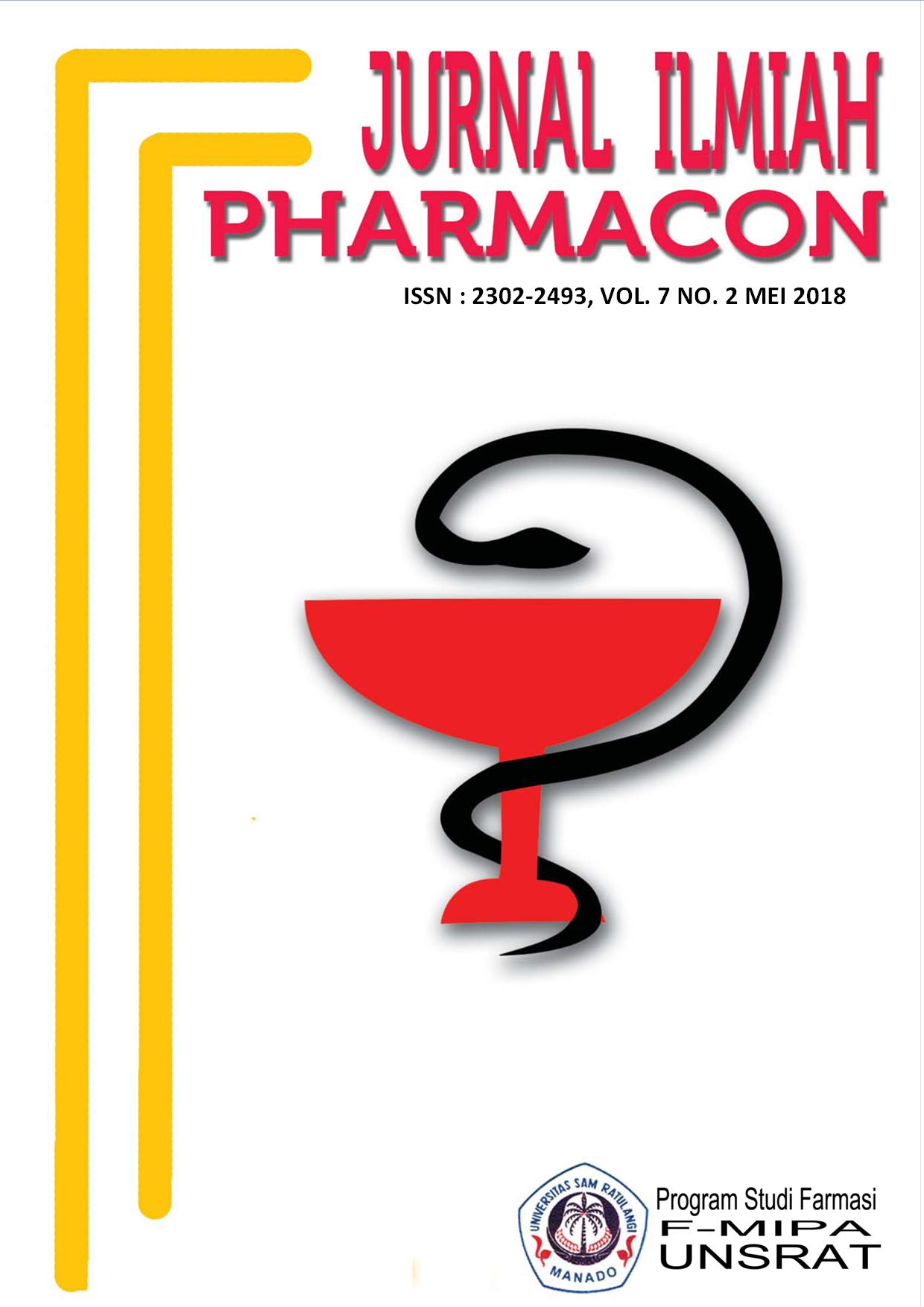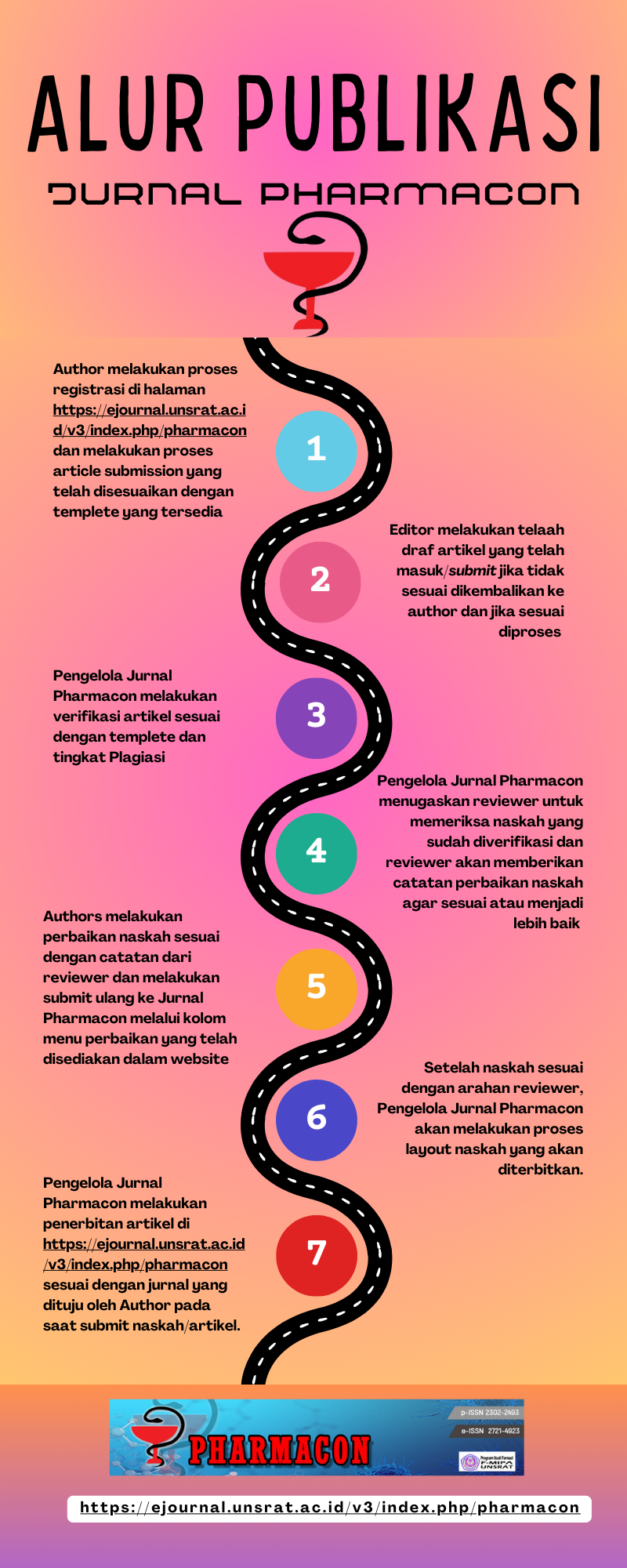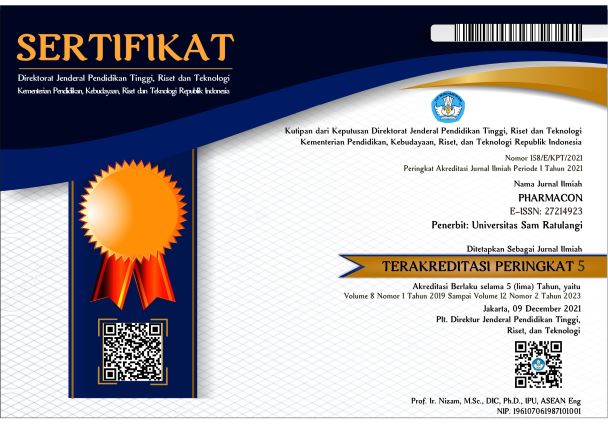ANALISIS EFEKTIVITAS BIAYA PENGOBATAN PASIEN PEDIATRIK DEMAM TIFOID MENGGUNAKAN CEFIXIME DAN CEFOTAXIME DI RSU PANCARAN KASIH GMIM MANADO
DOI:
https://doi.org/10.35799/pha.7.2018.19505Abstract
ANALISIS EFEKTIVITAS BIAYA PENGOBATAN PASIEN PEDIATRIK DEMAM TIFOID MENGGUNAKAN CEFIXIME DAN CEFOTAXIME DI RSU PANCARAN KASIH GMIM MANADO
Â
Kereh Meiryna Juliana Beatrix1), Gayatri Citraningtyas1), Sri Sudewi1)
  1)Program Studi Farmasi FMIPA UNSRAT Manado, 95115
Â
Â
ABSTRACT
Â
The highest prevalence of thyphoid fever in Indonesia in the age group of 5-14 years old. The mortality rate of typhoid fever in some areas was 2-5% of patients into asymptomatic careers, thus providing a new source of infection for the surrounding community. Treatment using antibiotics is the most widely used typhoid fever drug, related to the many incidences of bacterial infection suffered by many people. This study aims to determine which drugs are more effective between Cefixime and Cefotaxime in the treatment of pediatric typhoid fever in GMIM Pacaran Kasih Hospital Manado. Cost Effectiveness Analysis has been done using descriptive observational method with cross sectional design, retrieval data using retrospective approach through patient medical record data search. Based on the results obtained, the average total cost of pediatric typhoid fever patients who received cefixime were Rp. 2.546.912 while at cefotaxime were of Rp. 2.594.693. Based on patient free fever time, the value of ACER Cefotaxime were Rp. 1.179.406 per day of free of fever, while cefixime were Rp. 1.142.113 per dy of free of fever with ICER value of Rp. 1.592.700 per day free of fever. For long patient care, ACER cefotaxime value of Rp. 589.703 per day of care while cefixime of Rp. 585.497 per day treated with ICER value of Rp. 955.620 per day addition of length of stay. So in conclusion, cefixime is more cost effective than cefotaxime.
Â
Keywords : Cost Effectiveness Analysis, Cefixime, Cefotaxime, Typhoid Fever, Pediatrics
Â
ABSTRAK
Â
Prevalensi tertinggi demam tifoid di Indonesia terjadi pada kelompok usia 5–14 tahun. Angka kematian demam tifoid di beberapa daerah adalah 2-5% pasien menjadi karier asimptomatik, sehingga merupakan sumber infeksi baru bagi masyarakat sekitarnya. Pengobatan menggunakan antibiotik merupakan obat demam tifoid yang paling banyak digunakan, terkait dengan banyaknya kejadian infeksi bakteri yang diderita oleh banyak orang. Penelitian ini bertujuan untuk menentukan obat mana yang lebih efektif antara Cefixime dan Cefotaxime pada pengobatan demam tifoid pediatrik di RSU Pancaran Kasih GMIM Manado. Telah dilakukan penelitian Cost Effectiveness Analysis menggunakan metode observasional deskriptif dengan rancangan cross sectional, pengambilan data menggunakan pendekatan retrospektif melalui penelusuran data rekam medik pasien. Berdasarkan hasil didapatkan total biaya rata-rata pasien demam tifoid pediatrik yang mendapat cefixime sebesar Rp.2.546.912 sedangkan pada cefotaxime sebesar Rp.2.594.693. berdasarkan waktu bebas demam pasien, nilai ACER cefotaxime sebesar Rp.1.179.406 per hari bebas demam, sedangkan cefixime  sebesar Rp. 1.142.113 per hari bebas demam dengan nilai ICER sebesar Rp. 1.592.700 per hari bebas demam. Untuk lama rawat pasien, nilai ACER cefotaxime sebesar Rp. 589.703 per hari rawat sedangkan cefixime sebesar Rp. 585.497 per hari rawat dengan nilai ICER sebesar Rp. 955.620 per hari penambahan lama rawat. Sehingga dapat disimpulkan bahwa, cefixime lebih cost effective dibandingkan dengan cefotaxime.
Â
Kata kunci : Analisis Efektivitas Biaya, Cefixime, Cefotaxime, Demam Tifoid, Pediatrik
Â
Â
Â
Â
Downloads
Published
How to Cite
Issue
Section
License
Authors who publish with this journal agree to the following terms:
- Authors retain copyright and grant the journal right of first publication with the work simultaneously licensed under a Creative Commons Attribution-NonCommercial 4.0 International License that allows others to share the work with an acknowledgement of the work's authorship and initial publication in this journal.
- Authors are permitted and encouraged to post their work online (e.g., in institutional repositories or on their website) prior to and during the submission process, as it can lead to productive exchanges, as well as earlier and greater citation of published work (See The Effect of Open Access)










